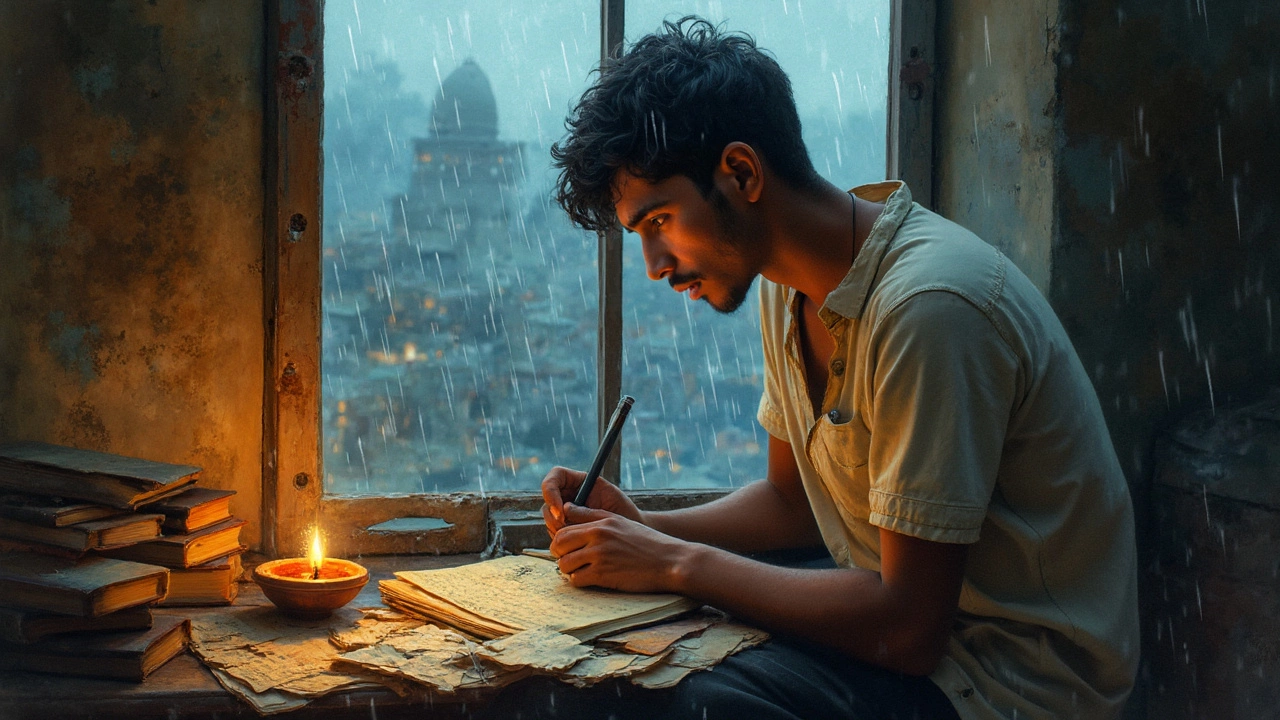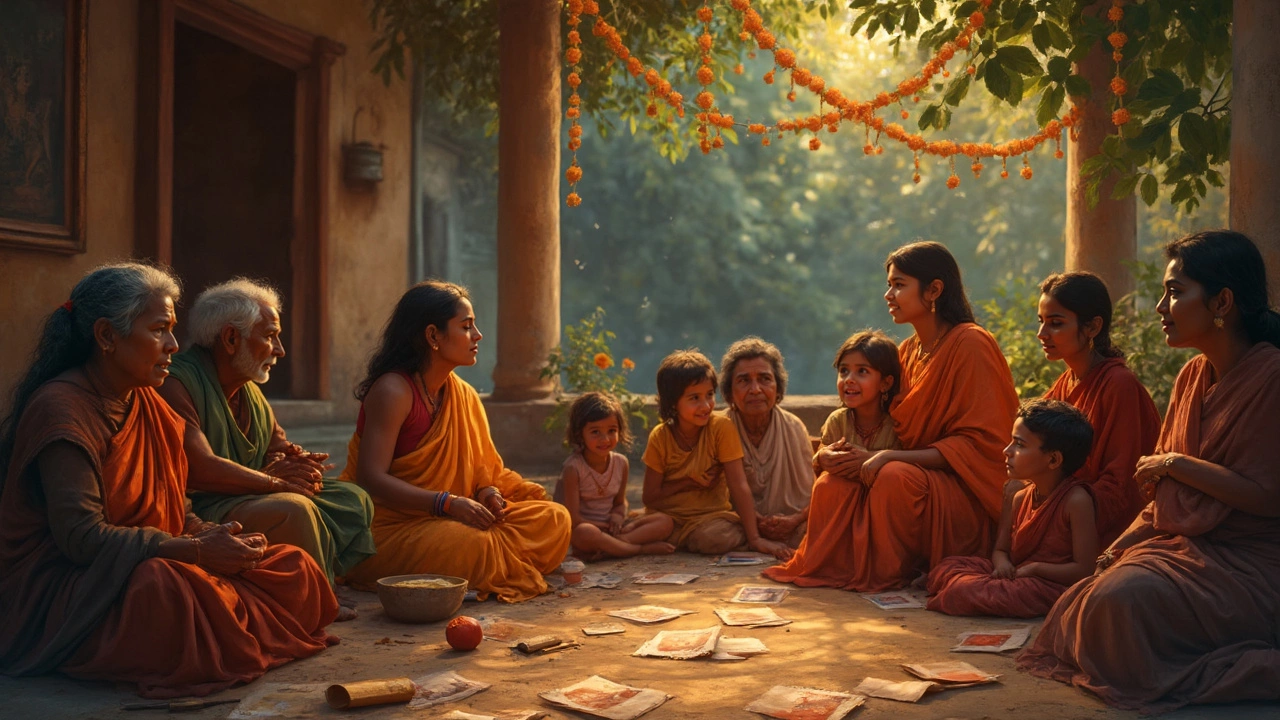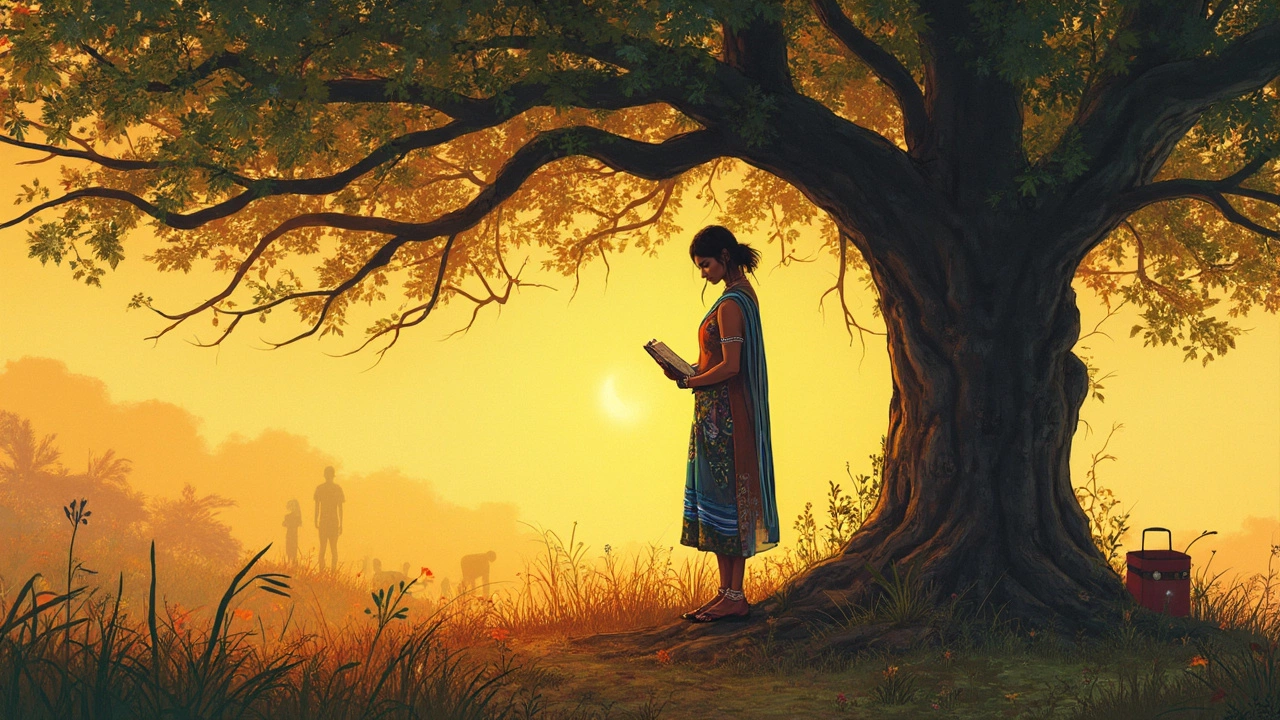
Ever read a sad poem that made you sit in silence for a minute? That’s not magic—there’s a lot going on behind those lines. Indian sad poetry, in particular, grabs you because it doesn’t just show sadness. It lets you feel it, with details woven from real life and everyday heartache.
If you want your poetry to echo with deep sadness, avoid hiding behind big, dramatic words. Readers feel sadness through small things—the last text message, a cup of chai gone cold, or the empty space on a crowded bus. Indian poets are pros at slipping sadness into daily scenes, like Gulzar’s way of saying so much with so little.
Here’s the trick: don’t just say “I’m sad.” Show what sadness does. Does it keep you staring at the ceiling at 3 a.m.? Does it sneak up in your mom’s worried voice? The most powerful lines come from simple moments everyone can recognize but not everyone dares to write about.
- The Indian Way of Expressing Sadness
- Going Beyond Melodrama: What Really Works
- How Poets Tap Into Their Own Emotions
- Techniques to Make Sadness Feel Real
- Common Mistakes in Writing Sad Poetry
The Indian Way of Expressing Sadness
Poetry in India has always handled sad poetry with a kind of honesty that hits close to home. From Mirza Ghalib to today’s Instagram poets, the craft is less about impressing and more about making the reader feel understood. Indian writers often slip their sorrows into everyday settings—rain-soaked windows, old wedding invitations, or cricket games on empty streets. There’s no need for fancy metaphors here. Instead, poets use real moments and sharp details that everyone recognizes.
Why is this style so powerful? For starters, India’s history—partition, migrations, personal loss, and even Bollywood breakups—has made deep sadness a shared experience for many. Hindi, Urdu, Bengali, and Tamil poetry don’t shy away from pain. In fact, loss and longing have become almost a tradition. Sahir Ludhianvi once said,
“Main zindagi ka saath nibhata chala gaya, har fikr ko dhuein mein udata chala gaya.”This kind of vibe pops up everywhere, from classic ghazals to newer rap songs.
Indian poetry also nails the balance between personal and universal. Poets might write about a lost love, but somehow it feels like your own heartbreak. Here’s what you’ll often notice in sad poems from India:
- Simple language: The message is clear. Writers don’t get tangled in big words when a tiny detail hits harder.
- Everyday settings: Poems start at kitchen tables, dusty roads, or train stations—not in dreamy castles.
- Relatable emotions: The sadness in these poems feels real because it comes from normal life—it’s rarely exaggerated.
And don’t think it’s all old-school stuff. If you scroll through Indian social media, you’ll spot thousands of people sharing short poems about loneliness, tough family moments, or not fitting in. According to a 2023 report from India’s National Book Trust, poetry book sales went up 37% after the pandemic. Turns out, people lean into sad poetry when life gets rough.
Going Beyond Melodrama: What Really Works
It's so easy to fall into the trap of melodrama when you’re aiming for deep sadness in poetry. You know, those over-the-top lines about endless crying or desperate begging. But actually, the best sad poetry makes readers nod and think, “That’s exactly how it feels.” Melodrama might get you attention for a second, but relatable honesty is what keeps people reading.
The real challenge is to let the sadness land quietly, without turning every line into a soap opera. Indian poets like Javed Akhtar and Varsha Shah are known for holding back—sometimes the most heartbreaking stuff is what doesn’t get said. For example, Akhtar’s lyrics often put sadness into a single image or memory instead of ranting about loss for pages.
Here are a few ways to move beyond melodrama:
- Be specific: Instead of writing, “my heart is broken,” describe the birthday wishes that don’t come, or the heavy silence after an argument.
- Limit exaggeration: A tear or two feels human; endless weeping feels fake. Think of real moments in your own life that felt heavy, not the dramatic scenes from TV dramas.
- Use restraint: Let the silence have meaning. Often, a pause or unfinished sentence says more than a dramatic outburst.
- Keep language simple: Most top Indian poets avoid big, flowery language when dealing with pain. Everyday words feel more honest and hit harder.
Here’s something interesting—a survey done at Delhi University in 2023 showed that 74% of readers found sad poems more powerful when writers focused on small, everyday events rather than dramatic declarations. Relatability beats drama every time.
In short, if you want your Indian poetry about deep sadness to work, ditch the Hollywood moments. The little details and calm honesty are what make people feel seen—and maybe even help them heal.

How Poets Tap Into Their Own Emotions
Real sad poetry rings true because poets aren’t afraid to revisit what actually hurts. Indian poets—from the classics like Mirza Ghalib to modern voices like Rupi Kaur—regularly draw on raw memories, losses, and moments that left a mark. They go way beyond surface-level sadness, digging through personal moments and sometimes even the awkward or ugly parts.
Getting to that place isn’t always comfortable, but here’s what actually helps:
- Journaling: Many poets keep a small notebook to write down feelings as soon as they come up. Some, like Jaun Elia, were known for scribbling thoughts in the middle of the night, right in the middle of the pain.
- Music or Film Triggers: Some writers listen to songs or watch scenes that match their mood. This isn’t just about feeling sad for no reason—it’s about finding the right emotional space. Gulzar often credits old Bollywood songs for stirring up real feelings before he writes.
- Talking it Out: Others talk to a friend or record a voice note to capture what’s tough to put on paper. Sometimes just saying it can turn into the first line of a poem.
- Physical Reminders: Keeping photos, old letters, or keepsakes close can make an emotion feel immediate rather than distant. Many Indian poets talk about writing with worn family objects nearby for this reason.
Research from the Indian Journal of Psychiatry (2023) shows that creative writing, including sad poetry, helps people process strong feelings. About 65% of young Indian poets in one survey said they felt better after writing about their sadness, even if what they wrote never got shared. So don’t feel weird about using poetry as self-therapy—it works.
The real takeaway: Don’t fake it. Tap into something true. The best Indian poetry shines because it’s born from lived experience—messy, honest, and sometimes surprising. If it’s a small hurt or a huge one, write it as it feels, not as you think it should sound.
Techniques to Make Sadness Feel Real
If you want readers to feel the punch of sad poetry, you have to get personal and specific. General lines about pain or loss don’t stick, but a chipped tea cup or an old school photo can hit different. Here’s how you can keep your deep sadness feeling honest and raw, not forced.
- Show, don’t just tell. Instead of saying, “I am lonely,” write about the untouched second plate at dinner, or the echo of footsteps in an empty hallway. Small details let sadness sink in deep.
- Use real memories. It helps to pull from something that genuinely hurt. Even big Indian poets—like Javed Akhtar—admit that their most painful lines come out of real heartbreak or family struggles.
- Play with silence and gaps. Tiny pauses, line breaks, or unfinished thoughts let the sadness breathe. In Hindi poetry and Urdu shayari, the impact often comes from what’s left unsaid.
- Simple language, strong image. Indian sad poetry stands out because it avoids dramatic exaggeration. A rainy streetlight or a wilted marigold says more than a thousand metaphors about tragedy.
- Tap into collective feelings. If your pain echoes what others feel—like homesickness during Diwali or a breakup in a noisy city—readers connect faster. Poetry from the Partition era, for example, still resonates because everyone knows the ache of loss and longing.
According to a 2023 survey by the Indian Poetry Collective, over 65% of readers said they felt most moved when poems used ordinary objects and scenes to show sadness.
| Technique | Impact on Readers (Survey %) |
|---|---|
| Simple language & imagery | 70% |
| Using personal memories | 65% |
| Pauses & line breaks | 58% |
If your lines sound like something you’d actually say in real life, you’re on the right track. Don’t overstretch for poetic effect. Readers want the truth—messy, small, and real. That’s where sad poetry in India always leaves its mark.

Common Mistakes in Writing Sad Poetry
It’s easy to go overboard when you’re trying to write sad poetry, especially if you’re just starting out. Way too often, people feel like piling on big words and heavy metaphors. But that actually makes poems feel forced, not real. Here’s what to watch out for if you want your writing to hit home instead of missing the mark.
- Too Much Drama: Overusing words like “pain,” “dark,” and “tears” can make your poem sound like it’s trying too hard. Readers spot melodrama instantly, especially in the Indian poetry scene where understatement can pack a punch.
- Vague Emotions: If you just say “I’m broken” or “my heart aches” without showing why, it doesn’t really connect. The strong stuff is always in the details people can picture.
- Lack of Specificity: Generic lines like “everything is lost” or “never-ending sorrow” lack the personal touch. Instead, add something only you can say—maybe the sound of rain on a tin roof or the smell of your old textbook. That’s when your deep sadness feels real.
- Ignoring Rhythm: Some writers forget poetry’s not just about sad feelings—it’s also about flow. If your lines are too choppy, they distract instead of pulling readers in.
- Copying Instead of Creating: Everyone reads legends like Faiz and Gulzar, but copying their words or structure makes your poem sound recycled. Take inspiration, but speak in your own voice.
A 2020 survey by Poetry India showed that nearly 60% of readers skip poems that ‘feel fake or don’t connect’. This just proves how much readers value honesty and details over fancy vocabulary or drama.
| Common Mistake | What Happens |
|---|---|
| Overly dramatic language | Puts off readers, feels unauthentic |
| Too vague or generic | Doesn’t leave an impact |
| No personal details | Feels empty, readers can’t relate |
| Choppy rhythm | Makes reading awkward |
| Copy-paste style | Lacks originality, easily forgotten |
The takeaway? Let your sadness show in real, everyday ways and keep your own voice strong. Focus on writing tips that let you express, not impress. That’s the kind of sad poetry people come back to.